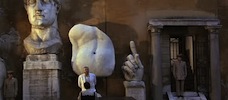Reviews
Peter Greenaway
UK, 1988
Credits
Review by Evan Kindley
Posted on 14 January 2010
Source bootleg DVD
Categories Peter Greenaway, Sacha Vierny, Michael Nyman, Ben van Os and Jan Roelfs
Calling a film anything “By Numbers” is always a dangerous proposition for a filmmaker, let alone one as monomaniacal and distinctive as Peter Greenaway. And it’s certainly true that those familiar with Greenaway’s work will scarcely be shocked by the content of his fifth feature film, which follows the stylistic templates established by The Draughtsman’s Contract (rustic English setting, complex sexual intrigue) and A Zed & Two Noughts (baroque ordering devices, concern with animals and identical twins) almost too perfectly. Still, it would be a tad too easy to call the film Greenaway By Numbers, if only because the director uses the conceit of repetition and limitation to thematic advantage this time around. Drowning By Numbers opens with a quintessentially Greenaway image: a little girl in a huge hoop skirt skips rope in front of a country house, illuminated by constantly shifting lights. As she skips she counts out stars by name, stopping once she gets to 100: “One hundred is enough. Once you’ve counted to one hundred, all the other hundreds are the same.”
This proudly arbitrary limitation both sets the film’s tone and presages its structure. Adapting the alphabetic schema of A Zed & Two Noughts, Greenaway counts us up to 100 in Drowning By Numbers, placing numerals at key points in the frame or sometimes embedding them into the dialogue, thus encouraging his viewers to play a sort of cinematic parlor game (or he would be, if he’d been able to resist providing a crib sheet in his companion volume Fear of Drowning). The film’s story follows three women named Cissie Colpitts - apparently a mother, daughter, and granddaughter, though it’s not entirely clear - as they plot to drown their husbands and cover it up with the help of a sexually frustrated coroner named Madgett. The same plot is thus repeated, with minor variations, three times over, building to a dénouement about as arbitrary as the film’s catalyzing incident (Cissie #1, played by Joan Plowright, finding her husband Jake cavorting in the bath with his mistress Nancy). While the characters, as usual for Greenaway, are little more than ciphers, Drowning benefits greatly from subtle performances by Plowright, Juliet Stevenson, and Joely Richardson as the three Cissies—the three women’s conspiratorial intimacy with one another is a rare source of warmth in an otherwise rather chilly film (and filmography).
The look of Drowning By Numbers is slightly unusual for Greenaway: the film was shot on location in East Anglia, mostly outside, mixing natural light with artificial in order to produce, in Greenaway’s words, “a surreal effect of trying to compete with God on his own lighting scheme.” The metaphor of competition is appropriate, since there is a protracted tussle going on throughout the film between Greenaway’s ultra-refined aesthetic and the provincial English setting. Greenaway has always been at once unmistakably English and indefinably alien (or pan-European, which for many English people comes to the same thing). 1
Drowning By Numbers is perhaps the most insistently English of his mid-period films, drawing on national traditions both real and imagined to fill out the simple tale of sex, extortion, and murder. (Some of the more bizarre and apparently Greenawayan - such as the necessity of informing bees of a death in the family - are in fact real practices.) While one suspects a satirical intent, the local touches are not without charm, and the film in fact has an essential pleasantness to it that makes it both easier to take and ultimately less effective than the oppressive, abattoir-like landscapes of A Zed & Two Noughts and The Cook, the Thief, His Wife & Her Lover. Occasionally the elaborate whimsy of early shorts like A Walk Through H is allowed to take over, with diverting results.
But Drowning By Numbers is still definitely a mid-period Greenaway film, firmly oriented around the polestars of sex, death, treachery and cosmic randomness. Where Zed contemplated the process of entropy and slow decay, Drowning interests itself primarily in sudden, violent death. “A great many things are dying violently all the time,” Madgett’s son Smut observes, and we are meant to understand that the murders orchestrated by the Colpitts are not any kind of break with the order of things, but merely helping the inevitable along. “Is any death natural?” the coroner muses a little later, though the question could easily be put the other way around (aren’t all deaths natural?). With a similar nonchalance, Smut marks each violent death that occurs in their village with different shades of paint depending on the day (yellow for Tuesdays, red for Saturdays).
This nonplussed, just-so attitude toward death - not so much a morbid interest as a pessimistic acceptance - has an august English heritage itself, of course. The name of the second Cissy’s husband, Hardy, while apparently suggested by the apocryphal last words of Lord Nelson, also recalls the poet and novelist Thomas Hardy, who patented the kind of rural fatalism Greenaway invokes back in the mid-nineteenth century. The link insistently made between sex and death goes back at least to the time of John Donne, and the film’s frequent allusions to necrophilia only make the old petit mort topos more explicit. (On the other hand, Greenaway at times suggests that sex and death are mutually exclusive: Madgett’s professional association with mortality is somehow associated with his being perpetually hard up: when he laments that “All coroners see are corpses,” Cissie #2 reminds him, “Well, they won’t reject you.”) Death and sex in this world are not scandals, but just mundane business as usual, and this blasé ethos is not as far from the normal world of the murder mystery as one might think. Among the narrative genres Drowning pokes curiously with a stick is another English specialty, the detective story à la Agatha Christie (with passing nods to Highsmith and Hitchcock as well: the scene where the three Cissies discuss the possibilities of collaborating on the murder of their husbands is very Strangers on a Train). Numbers play a role here too, helping the murders come to light - “How come a 6-foot man drowned in a 4-foot bath?” a minor character named Bognor asks about Jake’s death - and the very formal structure of the film suggests that time is running out for its characters, introducing an element of suspense that might otherwise be lacking.
But whatever their use value for mathematical deduction, numbers are also arcane objects with their own histories that are not those of reason, and Greenaway exploits their magical properties at least as much as he does their ordinal functions. “Drownings, like most things, come in threes”—but is this because there is a magical numerological basis to reality, or because people are creatures of habit who stamp familiar forms onto everything they see and do? Murder and murder-spotting are the same sort of thing for Greenaway’s characters: a pastime, a hobby, a game.
This is why Smut, despite his irrelevance to the central narrative, can be seen as the central character of Drowning By Numbers. A curious, lonely, intelligent young boy who spends his time counting, cataloguing, and reciting the rules to complex games, Smut is an obvious stand-in for the young Greenaway, though he is treated so brutally one wonders if there isn’t some degree of masochism at work here. The games Smut describes in voiceover - “Sheep and Tides,” “Dead Man’s Catch” and “Hangman’s Cricket” among them - comment on the action and sometimes even advance it; the byzantine rules point back to Greenaway’s early structuralist work and also participate in a British literary tradition more lately exemplified by the game of Quidditch in the Harry Potter books. (Like his son, Madgett is also interested in games, especially cricket. Midway through the film he gets Smut to pose for the illustrations of his planned Book of Cricketing Deaths—photographs which eventually come to the attention of the police, who mistake them for child pornography.) But Smut is rarely seen playing games himself: he prefers to taxonomize them, breaking down their rules and deep structure without giving himself over to the spirit of play.
Similarly, the many games provide readymade set pieces for Greenaway, giving him and Vierny opportunities to construct Felliniesque group scenes teeming with incidental (or is it?) detail. But where Fellini’s parties celebrated the joys and excesses of Italian communal life, often hurling his camera right into the midst of it, Greenaway organizes his spectacles like a careful ethnographer, always at a theoretical remove or two from the action. The caution, precision, and patience of the film’s scenes, while impressive and pleasurable in and of themselves, ultimately feel like a way of marking time and staving off boredom for Greenaway as much as for his characters. Once you’ve counted to one hundred, all the other hundreds are the same.
More Peter Greenaway, Sacha Vierny, Michael Nyman, Ben van Os and Jan Roelfs
-

The Falls
1980 -

The Draughtsman’s Contract
1982 -

A Zed & Two Noughts
1985 -

The Belly of an Architect
1987 -

Drowning by Numbers
1988 -

The Cook, the Thief, His Wife & Her Lover
1989 -

Prospero’s Books
1991 -

The Baby of Mâcon
1993
We don’t do comments anymore, but you may contact us here or find us on Twitter or Facebook.



